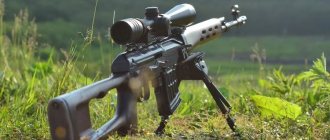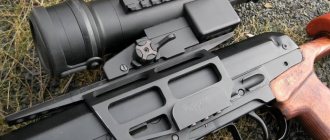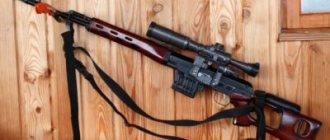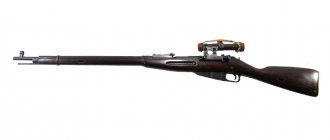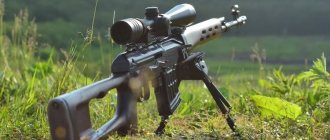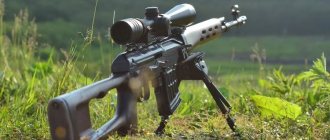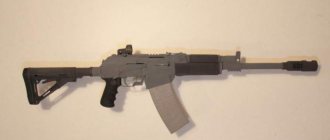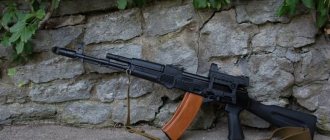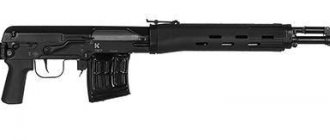The Tiger hunting carbine is a striking example of how a weapon created for military purposes serves well as a hunting weapon, so the Tiger carbine should be considered together with the SVD military rifle, from which it differs in minor design changes. When the SVD rifle was created, the designers were given the task of making a universal rifle that could be used not only as a sniper, but also for other purposes. The main task when creating most models of Russian small arms was to obtain a product that would be reliable and easy to use.
Although creating hunting weapons based on military models is not the best idea, Tiger carbines and other models of Russian carbines are the only alternative to imported models of rifled hunting weapons, since in Russia there is no production of rifled weapons designed specifically for hunting.
Let’s not argue that for the domestic hunter most imported analogues of rifled weapons are unavailable due to their high price and complexity of design. The Tiger carbine is an extremely reliable weapon that has excellent shooting characteristics and uses inexpensive ammunition.
The history of the appearance of the Tiger hunting carbine
The history of the appearance of the Tiger carbine begins in 1958, when the GRAU of the General Staff of the SA demanded the creation of a new sniper rifle for the army. Such weapons were required in order to replace the legendary “three-line”, which by that time was very outdated. The requirements for the new model were quite strict, and it seemed that it would not be possible to fulfill them all:
- The new rifle should be better than the three-line sniper in terms of reliability, while surpassing it in accuracy and maneuverability;
- The rifle was supposed to be designed for 7.62 caliber cartridges, which was used on the “three-line”;
- The number of cartridges in the new rifle should be twice as large as that of the “three-line” (10 pieces);
- The mass of the new rifle should be equal to the mass of the Mosin rifle.
Dragunov was able to embody all these properties in one rifle. It was his rifle that the military chose as a replacement for the “three-line” sniper. After IZHMASH took over the production of the SVD, it was put into service in 1963. The SVD is still in service and no replacement is expected in the near future.
The appearance of the Tiger carbine
The first carbines of the Tiger brand began to appear in the early 70s. For those who do not know which model of military weapon this carbine is a copy of, it is a hunting modification of the Dragunov rifle. The basic version of the Tiger is chambered for the same caliber cartridges as those used for SVDs, only they use semi-jacketed bullets. These cartridges are marked 7.62x54.
The Tiger carbine turned out to be as unpretentious and reliable as the model that served as its donor (SVD). It is also easy to operate and clean, and its rate of fire and automatic mechanism do not cause any problems during operation. If it is necessary to shoot with open sights, this can be done without removing the optical sight. The magazine for the Tiger hunting carbine comes in two modifications – for 5 or 10 rounds. The length of the carbine was no different from the length of the SVD, only the Tiger also came in a short version. The barrel length of the short Tiger was 530 mm, while the barrel of the SVD and standard Tiger was 620 mm long.
The operation of the first models of Tiger carbines showed that this design is not always convenient for hunters and has many minor drawbacks:
- The standard army optics of the PSO-1 model turned out to be not very suitable for hunters. Many people got out of this situation by installing other optical sights for the Tiger carbine. Optics, selected by a specific hunter specifically for his needs, were superior to standard optics in all respects;
- The standard stock for the Tiger carbine was orthopedic, which created certain inconveniences for many hunters;
- The first Tigers were equipped with plastic linings on the forend. This, of course, made the design of the 7.62 Tiger carbine easier, but it was not suitable for hunting in the cold, since the plastic not only froze the fingers very much, but also creaked at low temperatures;
- The barrel of the hunting carbine was not equipped with a flash suppressor, which made it difficult to hunt in the dark, since the bright flash when fired blinded the hunter.
These shortcomings were corrected only in 1996, when an export modification of the Tiger was created, which received the index “01”. This model was created to enter the European and American markets; at the same time, the manufacturer decided to correct the shortcomings that consumers had been complaining about for several years.
The new Tiger 01 carbine has been modified as follows:
- Now any optics could be installed on the carbine, since the carbine began to be equipped with a universal side mount;
- The barrel received a universal flame arrester, which reduces the glare effect. Although users who often hunt at dusk are still dissatisfied with the standard flash hider and install longer models on the barrel;
- The stock has changed, a pistol grip has been added;
- There is now the possibility of extended front sight shift.
All modern Tiger models come in the following weapon calibers:
- "Tiger" chambered for 7.62x54R;
- Carbine "Tiger" chambered for Winchester (.308Win);
- "Tiger-30-06", which uses .30-06Sprg (7.62x63) caliber cartridges;
- "Tiger-9", using 3x64 cartridges;
- There are also “Tigers” with a folding stock.
We can look at the Tiger-9 model in more detail. The fact is that caliber 9.3 x64 is extremely rarely used in our latitudes. 9.3x64 caliber cartridges are designed for hunting very large animals. It is the 9.3 x64 caliber that is used when hunting elephants. Some novice hunters are so impressed by the parameters of the 9.3 x64 caliber cartridge that, without hesitation, they buy Tiger-9 carbines for hunting, which they basically do not need.
Hunting with the "Tiger"
The main feature of hunting with the Tiger carbine is the fact that the weapon forgives the novice most of the mistakes at the moment of shooting. All this is thanks to a fairly soft trigger, due to which the twitching of the aiming bar at the moment the trigger is pulled remains minimal. Of course, many may not like the fact that the weapon will be convenient only for shooting offhand. However, when using an open sight, this problem does not occur. So here you have to choose - shoot as you like, but without optics, or offhand, but with an optical sight.
Despite the fact that 7.62x54R caliber bullets do not have great destructive power, the power of the carbine completely compensates for this disadvantage. The rifle can be safely used for hunting large animals, and will also be effective for hunting fur-bearing animals, because a seven-millimeter bullet practically does not spoil the trophy value of fur. But for hunting game birds, you should choose something else (best of all from the smooth-bore gun category), since such a caliber will be too large for the bird.
The Tiger carbine is a self-loading weapon that does not require constant refilling of cartridges into the receiver. If the hunter's shooting skills are high enough, then he can manage to shoot at the target a second time before the sound from the first shot reaches it (it is impossible to install a silencer due to the flash suppressor). At the same time, a 5-round magazine is more than enough for successful fishing. Well, if you think that this is not the case, then simply choose to purchase the version that comes with a magazine for 10 rounds of ammunition.
Sighting the Tiger carbine is a very important step that should be completed before going into the forest to hunt the animal. It is highly recommended to carry out such work using a special locking machine, since this is the only way the weapon will show that it has minimal dispersion even at sniper distances. It is completely unnecessary to install optics for hunting, since the standard sighting device is designed for shooting from a distance of up to 250 meters.
It is not for nothing that the Tiger carbine is the most popular rifled rifle for hunting. It combines all the positive design qualities that are inherent in the SVD, and also has impressive performance characteristics. The weapon is unpretentious in maintenance and forgives the owner even the most dismissive attitude. Well, the opportunity to carry out modifications with your own hands, using a combined sighting bar, should appeal to almost everyone who likes to stand out with unique tuning or simply install a body kit on a weapon.
Features of the design and operation of the Tiger carbine
Although most Tiger carbines used for hunting are automatic, there are also non-self-loading options. Automation in carbines operates using the energy of powder gases and the energy of return springs, which eject spent cartridges and send the cartridge into the chamber.
The stock and pads on modern Tigers are made of various types of natural wood or plastic. The wooden butt is equipped with a rubber backplate, which protects the hunter’s shoulder well during recoil. The shooting range without an optical sight is 300 meters, and the sight itself consists of a bar and a front sight, which can be adjusted in two planes.
The main feature of the Tiger rifled carbine is the unique barrel manufacturing technology, which is made using the same technology as SVD barrels. This technology is not used anywhere else:
- The barrels are drilled from the blank using oil under pressure;
- The resulting hole is reamed;
- The smooth channel is additionally polished using electrical discharges;
- Using electroerosion technology, the necessary rifling is formed in the barrel. It is difficult to say how the plant achieves such precision, since this technology is unique and kept secret;
- Next, the barrel is sent for metalworking;
- After processing, the barrel is hardened and the internal bore is chrome plated.
The service life of a barrel made using this technology is stated to be 6,000 shots.
Design and performance characteristics of the Tiger carbine
The Tiger carbine consists of 8 main parts:
- barrel with receiver;
- bolt frame with bolt;
- forend;
- butt;
- trigger mechanism;
- gas engine;
- return mechanism;
- flame arrester.
An open sighting device is located on the flash suppressor. The carbine is also equipped with an optical sight.
The Tiger barrel has 4 grooves. Their stroke length can be 320 or 240 mm. Barrels for SVD and Tiger rifles are manufactured using a unique technology:
- the metal workpiece is drilled under high oil pressure;
- the channel is double scanned and then polished with an electric discharge;
- rifling in the channel is obtained by electroerosion: the workpiece is placed in a special solution, a tool is inserted into it, on which copies of the rifling are located, and under the influence of an electric discharge the barrel acquires the required configuration;
- after this, the barrel blank undergoes turning, as a result, the outer surface receives the desired geometry;
- the barrel undergoes heat treatment;
- then it is plated with chrome.
The declared life of the carbine barrel is 6000 shots.
The barrel bore is locked with three lugs after turning the bolt around its axis. The design is designed in such a way that if it is not fully locked, a shot is impossible. Unlocking the channel begins after the bullet leaves the barrel. This reliable and safe automation system, which works flawlessly, was borrowed from SVD. When the cartridges run out, the bolt carrier and bolt are locked in the rear position, signaling that the magazine needs to be reloaded.
During firing, this rifled carbine is automatically reloaded using the energy of the powder gases, which are diverted from the barrel into the gas chamber, as well as the energy of the return springs. To fire the next shot, you need to release the trigger and press it again.
The Tiger carbine is equipped with a flag-type safety, which has two possible positions - “fire” and “safety”. When it is moved to the second position, the trigger is blocked, and retracting the bolt frame back becomes impossible.
The PSO-1 military sight, which is used by snipers, is not suitable for hunting. It weighs 580 g, has large dimensions and is too complex. The sighting reticle is designed for distances up to 1300 m and is equipped with a scale designed for targets the size of an average human height - 1.7 m high.
But the carbine has a side bracket for attaching hunting scopes with variable magnification. In many cases, when the game has to be shot short and offhand, optics turn out to be superfluous and only hinder the shooter.
The main differences between the Tiger and the SVD:
- shortened barrel - 530 mm versus 620;
- modified shape of the butt, which was also reduced;
- the sighting bar is graduated at 300 m instead of 1200;
- modified form of flame arrester;
- open, non-vertically adjustable front sight;
The design of the "Tiger" has changed over the years, so there are different modifications of the carbine - in some of them the front sight is adjustable in height, in some there is a flash suppressor, the barrel length can be 590 or 620 mm instead of 530 mm. There are carbines on sale with both a standard hunting butt and an orthopedic one, which has a hole for the hand.
The weight of the modification with a barrel length of 530 mm is 3.8 kg without an optical sight, the total length is 1090 mm. The Tiger can be equipped with a magazine for 5 or 10 rounds.
How to zero the Tiger carbine
The Tiger carbine is zeroed from a prone position. In this case, the initial distance for zeroing should be chosen no more than 50 meters; from such a distance it is easier to determine if the sight line does not coincide with the axis of the barrel bore. After the first shots, you can determine how to adjust the aiming line. The task of adjustment is to maximize the alignment of two points - aiming and hitting.
After making adjustments at a distance of 50 meters, you should zero in at a distance of 100 meters. Next, zeroing is repeated every 50 meters up to 300.
As for the accuracy of the Tiger carbine, the specified accuracy of the Tiger ranges from 18 to 30 mm, which is an excellent indicator of accuracy for this weapon. Many hunters often complain that the accuracy of their specimens does not reach the passport level, and in reality is equal to 50 millimeters. It is possible that such large discrepancies are associated with insufficient skill of the hunters.
Reviews from hunters about the Tiger carbine
If you interview hunters who use Tiger carbines for hunting, you can understand that these weapons are quite popular. Most users hunt using 13 gram bullets. Heavier bullets are rarely used and mainly by beginners, as bullets with excess weight fly along a steeper trajectory, which makes aiming more difficult. 13 grams is enough to kill a large animal from a distance of 250 meters.
According to information from hunters, the Tiger carbine almost never misfires, since it is based on the military SVD model, for which misfires are an unacceptable phenomenon. For those hunters who prefer hunting at close and medium distances, we can recommend shortened carbine models. At such distances, their accuracy is practically no different from full-size models, but gives superiority in maneuverability and weight.
Experienced hunters do not recommend purchasing a model with plastic parts, and if you have already bought it, then it is advisable to replace the plastic with wood. With proper and easy care, the tree will not cause you unnecessary trouble. If the cartridges in the carbine magazine rattle when shooting, it is better to replace it with an SVD magazine, which will become like a “native” one.
Disassembling and assembling the Tiger carbine is not difficult even for a beginner, since the parts are made in such a way that it is simply impossible to assemble them in any other way.
For those who do not know which brand of cartridges is best to use for shooting from the Tiger carbine, it is worth recalling that you are dealing with a Russian-developed weapon that traces its ancestry to the legendary SVD, so the Tiger is completely “omnivorous” in terms of cartridges. It is better to buy a pack of Novosibirsk and Barnaul cartridges, and then shoot them in the field. After checking their accuracy, it is worth taking those with higher accuracy. The main thing when shooting is to remember that the flight of a bullet can be over 5 kilometers, so you need to follow all safety rules.
The Tiger's descent is quite easy and smooth, for which we should thank the same military SVD.
Tuning the Tiger carbine
The most important elements of tuning the Tiger hunting carbine are:
- Selection and installation of optics;
- Replacing plastic elements with wooden ones from SVD;
- Installing a magazine for 10 rounds instead of the standard one, designed for 5.
In addition, installing a silencer on the Tiger carbine is an optional procedure, but highly desirable, especially for fishermen. It will not be superfluous to purchase and install a bipod. And the most important thing that both beginners and experienced hunters need to do is to be sure to shoot the carbine with cartridges from different manufacturers in order to find the best ammunition for accuracy.
The Tiger carbine is the best domestically produced rifled semi-automatic weapon. However, if you do not have sufficient strength and endurance, and hunting involves covering long distances, it is better to look for a lighter foreign analogue.
When choosing a weapon, you should not rely on reviews from hunters, because a weapon that is suitable for one may not be suitable for another. Go to the store and try several different options; perhaps the Tiger will be inconvenient for you, or perhaps it will seem like the best weapon for hunting.
New in blogs
MAIN DIFFERENCES OF THE 'TIGER' CARBINE FROM the 'SVD' 7.62 mm caliber: I. Open (mechanical) sight - up to 300 m (optional installation of 1200 m is possible); 2. There is no gas regulator (installation on the 'TIGR' is also possible upon request); 3. Barrel length 530 mm (or 620 mm, like the SVD); 4. Receiver different from SVD. designs (without side milling and a number of other differences); 5. Different markings are applied to the receiver; 6. The rifling pitch of the TIGER since 1995 is 320 mm. (or -280 mm for some export deliveries), for 'SVD's 1969 the pitch is -240 mm. from 1963-1969 -320 mm. "TIGERS" before 1995 had a rifling pitch of -240, like the SVD). Since 1995, on TIGERS, rifling pitches of 240 mm are found extremely rarely (mostly these are barrels that have not passed the SVDashnys quality control department and are suitable for use, including custom-made ones) on special orders, and currently individual copies of SVD are produced with a pitch of -320 mm . ; 7. The TIGER barrel does not undergo cryogenic strengthening of the barrel and electrochemical polishing of the chrome coating (therefore, the service life of the TIGER carbine barrel is 4,000 thousand shots, for the SVD - up to 10,000 thousand shots); 8. Caliber 7.62 mm. maintained extremely rarely (mainly the real caliber of 'TIGERS' 7.63 mm - 7.65 mm); 9. The "TIGER" has a spring-loaded bolt striker, the "SVD" does not (to prevent "self-piercing" of imported cartridges); 10. Wooden buttstock 'TIGER'. differs in appearance, material and design from the wooden 'SVD' (before 1998). including, in addition to the SVDash ones made of glass-filled polyamide, the TIGER is also equipped with plywood (or laminated) barrel linings without ventilation holes; 11. The coating on SVDs produced before 1994 is the so-called “bluing”, since 1994 - “phosphate varnish”, on “TIGERS” - only the latter (except for early issues); 12 A flash suppressor of a different design (either completely absent, or a short 'TIGR' with an open or closed front sight, or a long one ('SVD') with a sawed-off bayonet stop, or the latter also with a sawed-off front part of the flame arrester); 13. The basic 'TIGER' magazine holds -5 rounds (sometimes they install the 'SVDashny' for -10 rounds); 14.The shape, width and profile of the rifling (angles of the fields and rifling, etc.) differ from the 'SVDashnyh' ones (requirement of the GUOOOP SOB of the Ministry of Internal Affairs of the Russian Federation): 15.Sighting of the mechanical sight according to a different, more simplified scheme; 16.Individual parts of the TIGER, unlike the SVD, are not calibrated (simplified process flow diagram and quality control department); 17. Optical sights installed, only civilian model PO, POSP, etc. (on the 'SVD' - PSO-1 (formerly), PSO-1M2, 1P59 'Hyperon' and a number of army night sights are installed);
Department of the chief designer of the concern 'IZHMASH'
